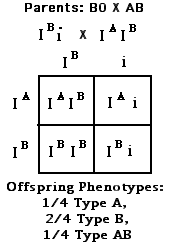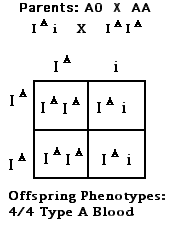
Blood Typing/ Multiple Alleles
A number of human traits are the result of more than 2 types of alleles. Such traits are said to have multiple alleles for that trait.
Blood type is an example of a common multiple allele trait. There are 3 different alleles for blood type, (A, B, & O). A is dominant to O. B is also dominant to O. A and B are both codominant.

Sample Blood Type Problems
 ------------------
------------------
 ------------------
------------------
Antigen: Protein on the surface of the blood cell. (Allele A makes A antigen. Allele B makes B antigen. Allele O makes no antigens.)
Antibody: Protein in plasma that reacts with specific antigens that enter the blood (usually something that isn't supposed to be there!). (Ex.: Anti-A is an antibody that recognizes A-antigen, binds to it (lock & key), then causes clumping together or clotting of similar A-antigens.)
Table Two: Distribution and Characteristics of Human Blood Factors
|
Blood Type
|
Distribution in USA (%)
|
Antigen on Red Blood Cell |
Antibody in Serum Plasma
|
Will Clot with Blood From These
Donors
|
Can Receive From
|
Can Give to:
|
|
O
|
45
|
None
|
Anti-A, Anti-B
|
A, B, AB
|
O
|
All
|
|
A
|
40
|
A
|
Anti-B
|
B, AB
|
A & O
|
A & AB
|
|
B
|
11
|
B
|
Anti-A
|
A, AB
|
B & O
|
B & AB
|
|
AB
|
4
|
A & B
|
None
|
None
|
All
|
AB
|
Type O Blood: Universal Donor as it contains no A or B antigens, so the receivers' blood will not clot when given the O blood.
Type AB Blood: Universal Receiver, as it contains no Anti-A or Anti-B antibodies in its plasma. It can receive all blood types.
Blood Type Distribution via Nation (Wikipedia)
Worldwide Distribution Maps of Each Blood Type Allele